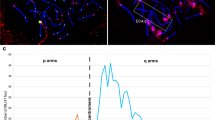Abstract
pKi-67 is a nucleolar antigen that provides a specific marker for proliferating cells. It has been shown previously that pKi-67's distribution varies in a cell cycle-dependent manner: it coats all chromosomes during mitosis, accumulates in nuclear foci during G1 phase (type I distribution) and localizes within nucleoli in late G1 S and G2 phase (type II distribution). Although no function has as yet been ascribed to pKi-67, it has been found associated with centromeres in G1. In the present study the distribution pattern of pKi-67 during G1 in human dermal fibroblasts (HDFs) was analysed in more detail. Synchronization experiments show that in very early G1 cells pKi-67 coincides with virtually all satellite regions analysed, i.e. with centromeric (alpha-satellite), telomeric (minisatellite) and heterochromatic blocks (satellite III) on chromosomes 1 and Y (type Ia distribution). In contrast, later in the G1 phase, a smaller fraction of satellite DNA regions are found collocalized with pKi-67 foci (type Ib distribution). When all pKi-67 becomes localized within nucleoli, even fewer satellite regions remain associated with the pKi-67 staining. However, all centromeric and short arm regions of the acrocentric chromosomes, which are in very close proximity to or even contain the rRNA genes, are collocalized with anti-pKi-67 staining throughout the remaining interphase of the cell cycle. Thus, our data demonstrate that during post-mitotic reformation and nucleogenesis there is a progressive decline in the fraction of specific satellite regions of DNA that remain associated with pKi-67. This may be relevant to nucleolar reformation following mitosis.
Similar content being viewed by others
References
Berrios S, Fernandez-Donoso R (1990) Nuclear architecture of human pachytene spermatocytes: quantitative analysis of associations between nucleolar and XY bivalents. Hum Genet 86: 103–116.
Billia F, de Boni U (1991) Localization of centromeric satellite and telomeric DNA sequences in dorsal root ganglion neurons, in vitro. J Cell Sci 100: 219–226.
Bridger JM, Kill IR, O'Farrell MK, Hutchison CJ (1993) Internal lamin structures within G1 nuclei of human dermal fibroblasts. J Cell Sci 104: 297–306.
Brown DC, Gatter KC (1990) Monoclonal antibody Ki-67: its uses in histopathology. Histopathology 17: 489–503.
Cooke HJ, Hindley J (1979) Cloning of human satellite III DNA: different components are on different chromosomes. Nucleic Acids Res 6: 3177–3197.
Collins C, Kuo WL, Seagraves R et al. (1991) Construction and characterization of plasmid libraries enriched in sequences from single human chromosomes. Genomics 11: 997–1006.
du Manoir S, Guillaud P, Camus E, Seigneurin D, Brugal G (1991) Ki-67 labelling in postmitotic cells defines different Ki-67 pathways within 2c compartment. Cytometry 12: 455–463.
Emmerich P, Loos P, Jauch A et al. (1989) Double in situ hybridization in combination with digital image analysis: a new approach to study interphase chromosome topography. Exp Cell Res 181: 126–140.
Fonatsch C, Duchrow M, Rieder H, Schlüter C, Gerdes J (1991) Assignment of the human Ki-67 gene (MKI67) to 10q-25-qter. Genomics 11: 476–477.
Frommer M, Paul C, Vincent PC (1988) Localization of satellite DNA sequences on human metaphase chromosomes using bromodeoxyuridine-labelled probes. Chromosoma 97: 11–18.
Gerdes J, Lemke H, Baisch H et al. (1984) Cell cycle analysis of a cell proliferation-associated human nuclear antigen defined by the monoclonal antibody Ki-67. J Immunol 133: 1710–1715.
Gerdes J, Li L, Schlüter C et al. (1991) Immunobiochemical and molecular biological characterization of the cell proliferation-associated nuclear antigen that is defined by monoclonal antibody Ki-67. Am J Pathol 138: 867–873.
Gerdes J, Schwab U, Lemke H et al. (1983) Production of a mouse monoclonal antibody reactive with a human nuclear antigen associated with cell proliferation. Int J Cancer 31: 13–20.
Granick D (1975) Nucleolar necklaces in chick embryo fibroblast cells. II. Microscope observations of the effect of adenosine analogues on nucleolar necklace formation. J Cell Biol 65: 418–427.
Hall PA, Levison DA (1990) Review: assessment of cell proliferation in histological material. J Clin Pathol 43: 184–192.
Hernandez-Verdun D, Gautier T (1994) The chromosome periphery during mitosis. BioEssays 16: 179–185.
Hofstadter F (1995) Cell proliferation assessment in oncology. Virchows Arch 427: 323–341.
Ijdo JW, Baldini A, Wells RA, Ward DC, Reeders ST (1992) FRA2B is distinct from inverted telomere repeat arrays at 2q13. Genomics 12: 833–835.
Ijdo JW, Wells RA, Baldini A, Reeders ST (1991) Improved telomere detection using a telomere repeat probe (TTAGGG)n generated by PCR. Nucleic Acids Res 19: 4780.
Isola J, Helin H, Kallioniemi O-P (1990) Immunoelectron microscopic localization of a proliferation-associated antigen Ki-67 in MCF-7 cells. Histochem J 22: 498–506.
Kaplan JC, Aurias A, Julier C et al. (1987) Human chromosome 22. J Med Genet 24: 65–78.
Kill IR (1996) Localization of the Ki-67 antigen within the nucleolus. J Cell Sci 109: 1253–1263.
Kill IR, Faragher RGA, Lawrence K, Shall S (1994) The expression of proliferation-dependent antigens during the life-span of normal and progeroid human fibroblasts in culture. J Cell Sci 107: 571–579.
Kill IR, Bridger JM, Campbell KHS et al. (1991) The timing of the formation and usage of replicase clusters in S-phase nuclei of human diploid fibroblasts. J Cell Sci 100: 869–876.
Kurz A, Lampel S, Nickolenko JE et al. (1996) Active and inactive genes localize preferentially in the periphery of chromosome territories. J Cell Biol 135: 1195–1205.
Leger I, Guillaud M, Krief B, Brugal G (1994) Interactive computer-assisted analysis of chromosome 1 colocalization with nucleoli. Cytometry 16: 313–323.
Li YP, Busch RK, Valdez BC, Busch H (1996) C23 interacts with B23, a putative nucleolar localization signal binding protein. Eur J Biochem 237: 153–158.
Lichter P, Cremer T. (1992) Chromosome analysis by nonisotopic in situ hybridization. In: Rooney DE and Czepulkowski BH, eds. Human Cytogenetics. New York: Oxford University Press, 1992.
Manuelidis L, Borden J (1988) Reproducible compartmentalization of individual chromosome domains in human CNS cells revealed by in situ hybridization and three-dimensional reconstruction. Chromosoma 96: 397–410.
McDermid HE, Duncan AMV, Higgins MJ et al. (1986) Isolation and characterization of an alpha-satellite repeated sequence from human chromosome 22. Chromosoma 94: 228–234.
Mears WE, Lam V, Rice SA (1995) Identification of a nuclear and nucleolar localization signals in the herpes-simplex virus regulation protein ICP27. J Virol 69: 935–947.
Schedle A, Willheim M, Zeitelberger A et al. (1992) Nucleolar morphology and rDNA in situ hybridization in monocytes. Cell Tissue Res 269: 473–480.
Scheer U, Hugle B, Hazan R, Rose KM (1984) Drug-induced dispersal of transcribed rRNA genes and transcriptional products: immunolocalization and silver staining of different nucleolar components in rat cells treated with 5,6-dichlorobeta-D-riboduranosylbenzimidazole. J Cell Biol 99: 672–679.
Schlüter C, Duchrow M, Wohlenberg C et al. (1993) The cell proliferation-associated antigen of antibody Ki-67: a very large, ubiquitous nuclear protein with numerous repeated elements, representing a new kind of cell cycle-maintaining proteins. J Cell Biol 123: 513–522.
Starborg M, Gell K, Brundell E, Höög C (1996) The murine Ki-67 cell proliferation antigen accumulates in the nucleolar and heterochromatic regions of interphase cells and at the periphery of the mitotic chromosomes in a process essential for cell cycle progression. J Cell Sci 109: 143–153.
Suziki M (1989) SPXX, a frequent sequence motif in gene regulatory proteins. J Mol Biol 207: 61–84.
Tagarro I, Fernandez-Peralta AM, Gonzalez-Aguilera JJ (1994) Chromosomal localization of human satellites 2 and 3 by a FISH method using oligonucleotides as probes. Hum Genet 93: 125–128.
Valdez BC, Perlaky L, Henning D et al. (1994) Identification of the nuclear and nucleolar localization signals of the protein p120-interaction with translocation protein B23. J Biol Chem 269: 23776–23783.
Verheijen R, Kuijpers HJH, Sclingemann RO et al. (1989a) Ki-67 detects a nuclear matrix-associated proliferation-related antigen. I. Intracellular localization during interphase. J Cell Sci 92: 123–130.
Verheijen R, Kuijpers HJH, van Driel R et al. (1989b) Ki-67 detects a nuclear matrix-associated proliferation-related antigen II. Localization in mitotic cells and association with chromosomes. J Cell Sci 92: 531–540.
Waye JS, Willard HF (1986) Structure, organization, and sequence of alpha satellite DNA from human chromosome 17: evidence for evolution by unequal crossing-over and an ancestral pentamer repeat shared with the human X chromosome. Mol Cell Biol 6: 3156–3165.
Weipoltshammer K, Schofer C, Almeder M et al. (1996) Spatial distribution of sex chromosomes and ribosomal genes: a study on human lymphocytes and testicular cells. Cytogenet Cell Genet 73: 108–113.
Yunis JJ, Yasmineh WG (1971) Heterochromatin, satellite DNA, and cell function. Science 174: 1200–1209.
Zirbel RM, Mathieu UR, Kurz A et al. (1993) Evidence for a nuclear compartment of transcription and splicing located at chromosome domain boundaries. Chromosom Res 1: 93–106.
Author information
Authors and Affiliations
Rights and permissions
About this article
Cite this article
Bridger, J.M., Kill, I.R. & Lichter, P. Association of pKi-67 with satellite DNA of the human genome in early G1 cells. Chromosome Res 6, 13–24 (1998). https://doi.org/10.1023/A:1009210206855
Issue Date:
DOI: https://doi.org/10.1023/A:1009210206855




